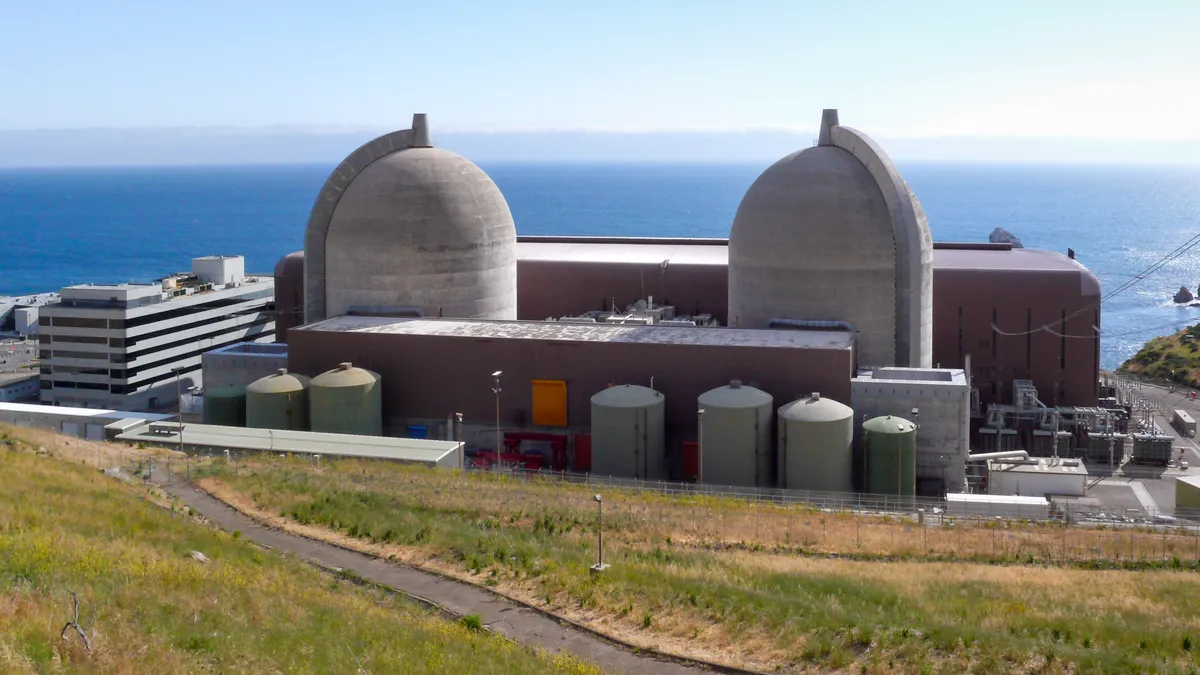Dive Brief:
- Pacific Gas & Electric’s plan to apply for a 20-year license renewal for the 2.2-GW Diablo Canyon nuclear plant at the end of this year will preserve the opportunity for the state to keep the facility open beyond the extension that California lawmakers placed on the table last year, a utility official said at a webinar held by the American Nuclear Society Thursday.
- PG&E’s biggest challenge at the moment is the time crunch, and the need to complete roughly five years of work in a year and a half, before the plant’s current licenses expire, Maureen Zawalick, the utility’s vice president of business and technical services at the Diablo Canyon plant, said.
- In 2018, California adopted a plan to retire the Diablo Canyon plant’s Units 1 and 2 in 2024 and 2025, respectively. Last year, however, lawmakers passed legislation that preserves the possibility of extending the facility’s operations through the end of the decade, largely because of concerns around grid reliability.
Dive Insight:
Multiple factors pushed California’s reversal on the future of the Diablo Canyon nuclear plant, including regulatory delays as well as supply chain crunches that made it difficult to bring new clean energy resources online in time. Last month, the California Energy Commission concluded that the state should pursue extending the life of the plant through 2030, in light of data that showed the state’s grid could fall short during extreme weather events.
PG&E began working last summer on measures that would need a couple of years of lead time, such as spent fuel management and purchasing uranium and fuel, Zawalick said.
That being said, “I don’t want people to think this is a done deal — we still need everyone’s help to get across the finish line, and we still have several regulatory processes left,” said Tom Jones, PG&E’s senior director of government relations.
The Diablo Canyon plant is currently on two tracks: PG&E is continuing to plan for the decommissioning of the plant some day, but also focused on continued operations beyond 2025. One avenue for this is filing an application with the Nuclear Regulatory Commission at the end of this year for a 20-year extension or “the maximum opportunity,” Jones said. However, the state of California also controls the operations of Diablo Canyon and will influence when that end date will be for the plant, he said.
A study conducted by Stanford University and the Massachusetts Institute of Technology in late 2021 found that California could save $2.6 billion in power system costs by extending Diablo Canyon’s life through 2035, and up to $21 billion by doing so through 2045.
On the question of whether Diablo Canyon could be extended for another 20 years, “we want to preserve the opportunity for the state by taking the licensing action with the NRC for 20 years, and that will be our submission at the end of this calendar year,” Jones said.
“The safe, reliable operations [of the plant] allow the conversation to occur, and so that’s our principal focus — so we want to be an irresistibly attractive option for the state of California,” he added.
PG&E has been working since last year on securing the items it needs to continue storing spent fuel at the plant, according to Zalawick. Spent fuel is currently stored in what’s called an independent spent fuel storage installation system, at around 310 feet above sea level, as well as in the spent fuel pool. The utility has the capacity to handle fuel from 60 years of operation on site.
More broadly, the U.S. needs to “work on finding a permanent solution to spent nuclear fuel in the long run,” Judi Greenwald, executive director of the Nuclear Innovation Alliance, said during the webinar.
“But our management of spent nuclear fuel as a society has been excellent… it certainly is something that’s important to manage very, very carefully and it takes effort to do so,” she said.
If PG&E’s license is renewed for another 20 years, the decision on whether or not Diablo Canyon can operate for the full period will be a state-led one, according to Diane Curran, an attorney for the group San Luis Obispo Mothers for Peace.
The California Legislature has currently allowed Diablo Canyon a five-year extension, “but they didn’t say we’ll never revisit that,” she added.














